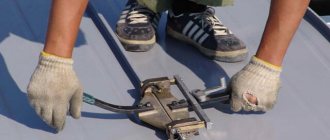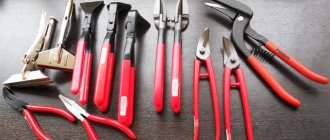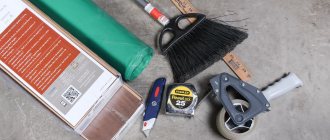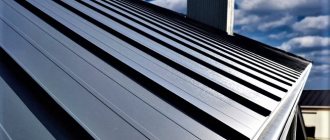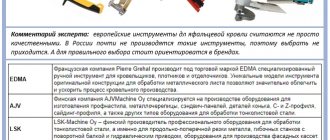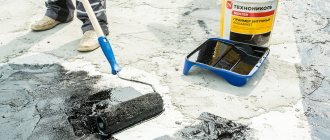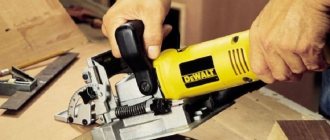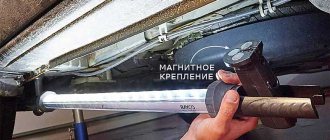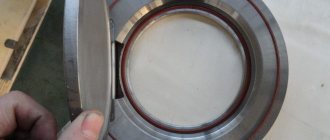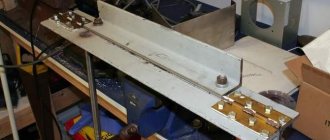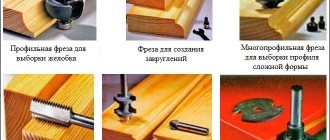Are you planning to re-roof your house with your own hands? Or maybe you want to master the profession of a roofer - one of the highest paid construction specialties? Whatever your goal, building a roof requires the right tools. Moreover, this is not only a special tool for roofing work, but also completely standard construction equipment, such as a tape measure or ruler, which is necessary for the construction of any roof.
Minimum set of manual roofing tools
Good seam roofing roofers have in their arsenal several dozen different tools, the presence of which makes it possible to solve all sorts of problems. Hand tools are vital for installing horizontal seams and individual roofing elements, such as exposed pipes, vents, ridge sections, etc.
A basic set of manual roofing tools is as follows:
- Wedge-shaped or rectangular mallet;
- Scissors that allow you to cut metal both straight and at an angle;
- Seam hammer with short handle;
- Roofing mandrel required for bending sheet metal;
- Pliers that allow you to separate double folds (haps);
- Set of pliers;
- Rebated chalazen.
Tool sharpening
It is necessary to ensure that the tools are in good condition, then the work will not require much effort. The sharpness of the sharpening is important if, for example, roofing scissors are used.
To sharpen a roofing knife or other tools, you can use:
- sharpener;
- sharpening stones;
- touchstone
Sharpener
. It is used for sharpening cutting tools, such as roofing metal shears, taking into account the following main points:
- Coarse-grained sharpeners leave defects - jagged marks and scratches, to remove which fine-grained ones are used;
- When sharpening planes and chisels, a round sharpener is directed towards the blade;
- The tip is placed completely on the surface of the sharpener and is moistened with water during the sharpening process.
Sharpening stones
. They are made from sandstone and used for rough sharpening. Large grains remove metal quickly. The blade is brought to working condition using a whetstone.
Touchstones
. When, for example, hand-held metal nibblers are sharpened, a whetstone moistened with water is used to polish their blades and remove burrs until a smooth, shiny surface is obtained. Sometimes files are used for sharpening, for example saws. Sharpening of drills for metal is done using sharpening discs, emery or corundum whetstones.
When sharpening hand electric shears for metal, it is done at an angle of 70 - 74 degrees.
Before you begin repairing or creating a roof, you should prepare tools and machines for roofing work in advance (if the roof surface is large in area). Modern equipment, such as a roof cutter, makes the work easier and allows you to equip the roof in the shortest possible time. Article on the topic: “Contract for roofing work and its significance.”
Double standing seam joints
To seam double seam joints, seam pliers or special frames are used, which include two separate devices, thanks to which this work can be completed in two passes. Such frames are especially relevant when arranging roofs in small but extremely inconvenient areas.
The first double rebate tool is required to start folding the corner rebate. There are no particular problems with this, and no physical effort is required, so in the vast majority of cases this operation is performed the first time. To close the double standing seam, it is necessary to repeat the operation with the second device.
Alloys used to make frames include bronze and stainless steel. Tools created in this way have two important advantages - firstly, they glide much better over the surface being processed, and secondly, the polymer layer located on metal sheets is not damaged by these alloys. Some models of roofing tools also have mechanisms for fixing them on metal sheets, which simplifies the work and improves the quality of the created lock.
Frames are perhaps the only tool for installing seam roofing, with which you can perform installation work that is located at a large slope or has a complex shape. Roofing frames are designed for a working width from 200 to 240 mm, and the maximum thickness of the metal with which they can work varies from 0.5 to 0.8 mm. For more accurate data, it is worth studying the documentation included with the tool.
The manual roofing tool for sheet iron roofing produced by STUBAI-Tooling Industries has proven itself to be the best. For production, the company uses high-carbon alloy steel, which is forged and sharpened by hand. Products of this brand are characterized by extreme wear resistance even with intensive use.
For installation and repair
Installation or repair of a seam roof cannot be done without a full set of special tools. We wrote a separate review about the cost of seam roofing, and about the types of seam roofing too. The quality of work, the tightness of connections, the durability of the coating - all these parameters directly depend on the availability of appropriate devices and on the qualifications of the specialists who use seam roofing tools in their work.
The composition of the kit largely depends on the type of roof and the method of joining the edges, but in any case you have to connect some sections manually, using all the necessary devices. Let's look at the most common of them:
Roofing mallet
A roofing mallet is an essential tool for a roofer and comes in many different shapes:
- round
- rectangular
- wedge-shaped
- small
- big
- with beveled handle
- fail-safe
They are made of plastic or wood and are used for manually forming a fold according to the appropriate template. There are a lot of offers on sale from different manufacturers; the user can choose the most convenient and suitable type of tool for him.
Roofing scissors
Scissors are an important tool for standing seam roofing, used in all cases of designing the final sections of the canvas, connecting with transversely directed patterns and in other cases. There are different types of metal scissors:
- pelicans
- perforated
- die-cut
- curly
- scoring
- checkpoints
In addition, there are universal scissors that can perform any of the specialized operations. A special feature of the professional tool is the ability to “cover” the cut with a layer of zinc, tightening the protective layer and joining it together. The cut edge is protected from contact with moisture, which is important for the safety of the fabric.
Roofing pliers
Another name for roofing mites is khapa. They are necessary for most operations and are available in different types:
- envelope
- frame
- edge
- “parrots” (used to open seams during repair work)
- big small
There are models designed to perform special types of connections:
- straight pliers are used to form seam joints
- curved pliers are used for finishing shaped elements, making ridges or edging bends
It is almost impossible to provide a complete list of tick species. This is a universal and multifunctional tool for standing seam roofing, which can be purchased in specialized stores. They are produced by various companies; the choice is very large and can satisfy any request.
Mandrels for forming folds
A mandrel is a specialized tool designed to form a fold by hand joining. There are many types of mandrels, differing in the size and shape of the support bar. Each type can provide only one type of connection, hence the variety of shapes and sizes.
During operation, the mandrel is applied to the side of the seam and, with hammer blows, the fold is bent along the edge of the support bar, making an even and uniform bend along the entire length of the joint.
For different types of folds or seam shapes, there are straight and radius types of mandrels, high or low, designed to form the primary or secondary bend of the joint. The prices for mandrels are quite high. Not every master can afford to have a large set of such devices, especially if he does not do roofing work at a professional level.
Roofing frames, manual sheet benders
Roof frames are used in sets of two types - primary and secondary frames. The primary ones create the first fold of the fold, and the secondary ones provide completion and sealing of the connection. They work on the principle of reverse pliers - the working jaws converge when the handles are pulled apart.
In addition to double frames for rebates, there are frames for cornices, which are used when decorating the lower overhang of the roofing sheet. High-quality frames are expensive, so it is advisable to purchase them only for regular use in work mode.
Do-it-yourself semi-automatic seaming machines
To speed up the process of installing a seam roof, you can use semi-automatic tools - they allow you to perform a high-quality connection of roofing panels in a shorter period of time than when using manual tools. Semi-automatic seaming machines are supplied in a kit that includes two devices necessary for alternate installation of the joint. In order for the seam roofing clamp to be connected, all you have to do is pull the machine behind you.
A semi-automatic machine for standing seam roofing has many advantages compared to manual tools:
- High speed;
- Good quality of the connecting seam along the entire length of the joint;
- Possibility of processing metal sheets of different thicknesses;
- Complete safety for the polymer layer located on the surface of the panels;
- Possibility of quick and high-quality installation of metal sheets on large roof areas.
Let's sum it up
In the article, we told you what tools are needed to build a roof, including the construction of a rafter system and the installation of a roofing pie, and which tools are needed for laying a specific type of roofing. We described both the minimum set of tools with which you can make a roof “from start to finish,” and gave examples of additional equipment that can speed up installation several times.
We recommend purchasing tools with ergonomic handles and made of high-quality steel. The amount of work when installing the roof of even a small house is quite significant, and when using cheap tools with plastic or metal handles, you will quickly get tired, which will affect both the duration and quality of the work performed. Where possible, use power tools, especially if working alone.
Electric sheet metal rolling machines
To minimize the amount of work that needs to be done manually, it is worth using electric seaming machines, which provide high-quality double joints with minimal effort from the roofer.
The work process looks extremely simple: the folding machine is installed on the required area and started. Moving along the site, the device reliably and efficiently closes the double vertical fold - and all this in a single pass over the panels. The result is a significant saving of effort and time.
When choosing electric tools for iron roofing, you should pay attention to the following models:
- Dimos K9. The French device with an electric drive is valued not only for the qualities inherent in similar devices, but also for the ability to process seams on arched roofs.
- Mobiprof FZM. This model of electric seaming machine uses unique profiling and drawing rollers.
- Schlebach Piccolo, FK1, Flitzer. All these brands of electric machines are manufactured in Germany and are distinguished by their original German quality.
Tools for roll installation of seam roofing
To implement roll technology, domestic Mobiprof machines are most often used, which make it possible to create roofing clamps without seams. It is best to carry out this type of work under the supervision of a professional roofer.
Installation is carried out using the following technology:
- First you need to lift the selected machine and rolled metal onto the roof;
- The metal strip is inserted into the working elements of the machine, rolled and cut;
- The prepared roofing panels are laid properly;
- Clamps (small-width metal strips that allow you to close all the gaps that may be in the roof) are attached to the sheathing;
- Using a hand-held roofing tool, a double seam joint is rolled up.
In order not to bother with manually creating a connection, you can use a machine that allows you to create self-locking folds. The SFPZ machine significantly speeds up the process of installing roofing panels. As a rule, such equipment is used on large gable roofs with a slope above 15 degrees.
Hole Making Tools
To make holes, use the following tool from a tinsmith - roofer:
- hand or electric drill;
- twist drills (see photo);
- different types of drills;
- countersink;
- countersink;
- punch.
Twist drill
. Its main components are: shank; machine and foot. The working part can be cylindrical or cutting. The shank is inserted into the spindle, which is equipped with a device that helps secure the drill into the rotating shaft. The cylindrical part of the tool for removing chips during the drilling process is equipped with two helical grooves with ribbons along the edges, which reduce friction on the edge. The cutting part of this tool is made in the shape of a cone - it has 2 cutting edges and one transverse edge. The sharpening angle, depending on the metal from which the workpiece is made, is 110-150 degrees.
Countersink
. It is used to process recesses of cylindrical or conical shapes. Using a countersink helps to machine prepared holes for mounting rivets, bolts and screws. There are 2 types of countersinks available for sale: conical and cylindrical. The conical countersink includes a working part and a shank, and the cylindrical countersink includes a working part with notches, a shank and a guide pin.
Countersink
. This tool is required for processing holes resulting from stamping, forging, drilling, etc. A countersink is similar to a drill, but it does not have two cutting edges, but more - 3, 4.
Punch
. It is used to create different holes. Instead of a punch, an all-metal roofer's hammer is often used.
Roofer tools, watch the video:
Advantages of the roll roofing method
Roll technology for arranging seam roofing has the following advantages:
- The roof is installed along the entire length of the slope without transverse seams;
- The panels are created directly on the construction site, which reduces the cost of transporting materials;
- The roll method allows you to create floating fasteners necessary to compensate for the thermal expansion of metal sheets;
- Thanks to the roll technology of arranging a seam roof, it is possible to minimize the amount of trimming and waste.
Conclusion
The entire range of roofing accessories is quite expensive, so it is simply not practical to purchase tools for standing seam roofing yourself if the installation will be done once. If there is a need to install a seam roof, it would be much better to use the services of a construction company with a good reputation that can provide experienced roofers for the work.
Conclusion
The installation of a seam roof is accompanied by labor costs, information content and the presence of a special tool. It will be easier and faster to contact a construction company, which is guaranteed to do its job for a fee. However, the installation technology is also available for beginners, so you can handle the task yourself.
There are metal sheets on sale with straight or ready-made edges that snap into place at the joints. In the first case, you will need a machine to form the profile. Ready-made paintings are more expensive, but installation work is carried out faster, since it will be enough to fasten the sheets and fold the folds using the chosen method.
